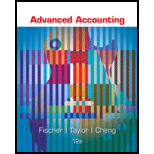
a.
Business combination:
Business combination refers tothe combining of one or more business organizations in a single entity. The business combination leads to the formation of combined financial statements. After business combination, the entities having separate control merges into one having a control over all the assets and liabilities. Merging and acquisition are types of business combinations.
Consolidated financial statements:
The consolidated financial statements refer to the combined financial statements of the entities which are prepared at the year-end. The consolidated financial statements are prepared when one organization is either acquired by the other entity or two organizations merge to form the new entity. The consolidated financial statements serve the purpose of both the entities about financial information.
Book value:
Book value of the asset is found out after deducting
The fair value of the asset:
The fair value of the asset is the amount at which two parties may enter into an agreement with an open hand.
Variable interest entity:
A legal business structure is known as variable interest entity when an investor has interest which is controlled even when not have majority of voting rights. Commonly, VIE activities includes leasing, financial assets, research and development, hedging financial instruments, and other arrangement transfers. Primary beneficiary is a term which is used to designate that party having control over VIE’s financial interest.
Whether the investment in equity of Company V will be recorded by the primary beneficiary.
a.
Explanation of Solution
The share of net income of Company V will be received by the primary beneficiary as per the terms of the contract. Thus, investment in equity of Company V will be recorded by the primary beneficiary. However, the primary beneficiary own debts and equities but these are not considered in the consolidation process.
b.
Consolidated financial statements:
The consolidated financial statements refer to the combined financial statements of the entities which are prepared at the year-end. The consolidated financial statements are prepared when one organization is either acquired by the other entity or two organizations merge to form the new entity. The consolidated financial statements serve the purpose of both the entities about financial information.
Whether Company V will be consolidated and if required then provide the adjustments.
b.
Explanation of Solution
The firm is required to consolidate the financial statements of a VIE with its own financial statements if the firm is the primary beneficiary in the VIE. The nature of being a primary beneficiary in the VIE can be determined by the following characteristics:
- If the firm is having right to receive the returns if they occur.
- If the firm is having right to share the losses if they occur.
- If the firm is having controlling interest in that VIE.
The entity must be consolidated in order to qualify for being primary beneficiary or variable interest entity.
The difference between the book value and the fair value of assets is $100,000. Thus, the variable interest entity will be increased by $100,000.
Want to see more full solutions like this?
- Please provide the solution to this financial accounting question using proper accounting principles.arrow_forwardI need help finding the accurate solution to this financial accounting problem with valid methods.arrow_forwardCan you explain this financial accounting question using accurate calculation methods?arrow_forward
- I am looking for help with this financial accounting question using proper accounting standards.arrow_forwardPlease provide the correct answer to this financial accounting problem using accurate calculations.arrow_forwardCan you solve this financial accounting problem with appropriate steps and explanations?arrow_forward
 Auditing: A Risk Based-Approach (MindTap Course L...AccountingISBN:9781337619455Author:Karla M Johnstone, Audrey A. Gramling, Larry E. RittenbergPublisher:Cengage Learning
Auditing: A Risk Based-Approach (MindTap Course L...AccountingISBN:9781337619455Author:Karla M Johnstone, Audrey A. Gramling, Larry E. RittenbergPublisher:Cengage Learning


